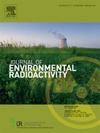Radio-sulphur (35S) detection by LSC – How to deal with interfering natural radionuclides
IF 2.1
3区 环境科学与生态学
Q3 ENVIRONMENTAL SCIENCES
引用次数: 0
Abstract
Naturally occurring radio-sulphur (35S) is suitable as an aqueous environmental tracer for the dating of groundwater and surface waters with residence times of less than one year. As a β-decaying radionuclide, 35S is detected using liquid scintillation counting (LSC). When extracting 35S as sulphate from large-volume water samples, there is the possibility of unintentional co-extraction of other naturally occurring radionuclides, which interfere with the measurement of 35S by LSC. The most important of these radionuclides are (i) 226Ra, (ii) the short-lived progeny of 222Rn, (iii) 210Pb and its progeny and (iv) 3H. In addition, 14C, which might be present in scintillation cocktails or LSC plastic vials, and 40K, which is likely to be present in LSC glass vials, can have a significant impact on the LSC detection result. There are a few publications that address sample preparation for 35S detection with LSC. However, the published datasets do not contain sufficiently detailed information to pursue the issue of potential interferences of the said naturally occurring radionuclides with the 35S signal. In our study, we measured standardized samples containing the said radionuclides by LSC, evaluated location, shape and overlap of the associated energy peaks, and assessed the possible influences of the individual nuclides on the 35S detection results. The findings of our study show that when measuring 35S obtained from a natural water sample, counts detected in the 35S energy window cannot be unconditionally interpreted as actual 35S counts. Interfering nuclides (especially 3H, 14C, 40K, and 210Pb) can lead to counts in the 35S energy window and thus to an overestimation of the 35S activity concentration of the water sample (and consequently to an underestimation of the water age). We therefore recommend generally a complete evaluation of the LSC spectrum in order (i) to be able to infer the potential presence of other radionuclides in the measured sample, and (ii) to evaluate the DPM counted in the 35S energy window accordingly, as these may contain counts of the aforementioned interfering radionuclides.
LSC法检测放射性硫(35S) -如何处理干扰性天然放射性核素
天然存在的放射性硫(35S)适合作为水环境示踪剂,用于地下水和地表水的测年,停留时间少于一年。作为一种β衰变放射性核素,35S是用液体闪烁计数(LSC)检测的。当从大体积水样中以硫酸盐形式提取35S时,可能会无意中同时提取其他天然存在的放射性核素,从而干扰LSC对35S的测量。这些放射性核素中最重要的是(i) 226Ra, (ii) 222Rn的短寿命子代,(iii) 210Pb及其子代和(iv) 3H。此外,闪烁鸡尾酒或LSC塑料瓶中可能存在的14C和LSC玻璃瓶中可能存在的40K对LSC检测结果会产生重大影响。有一些出版物讨论了用LSC进行35S检测的样品制备。然而,公布的数据集没有包含足够详细的信息,以探讨上述自然产生的放射性核素对35S信号的潜在干扰问题。在我们的研究中,我们用LSC测量了含有上述放射性核素的标准化样品,评估了相关能量峰的位置、形状和重叠,并评估了单个核素对35S检测结果的可能影响。我们的研究结果表明,当测量从天然水样中获得的35S时,在35S能量窗口中检测到的计数不能无条件地解释为实际的35S计数。干扰核素(尤其是3H、14C、40K和210Pb)会导致35S能量窗口的计数,从而高估水样的35S活度浓度(从而低估水的年龄)。因此,我们一般建议对LSC光谱进行全面评估,以便(i)能够推断被测样品中其他放射性核素的潜在存在,以及(ii)评估35S能量窗中计算的DPM,因为这些DPM可能包含上述干扰放射性核素的计数。
本文章由计算机程序翻译,如有差异,请以英文原文为准。
求助全文
约1分钟内获得全文
求助全文
来源期刊

Journal of environmental radioactivity
环境科学-环境科学
CiteScore
4.70
自引率
13.00%
发文量
209
审稿时长
73 days
期刊介绍:
The Journal of Environmental Radioactivity provides a coherent international forum for publication of original research or review papers on any aspect of the occurrence of radioactivity in natural systems.
Relevant subject areas range from applications of environmental radionuclides as mechanistic or timescale tracers of natural processes to assessments of the radioecological or radiological effects of ambient radioactivity. Papers deal with naturally occurring nuclides or with those created and released by man through nuclear weapons manufacture and testing, energy production, fuel-cycle technology, etc. Reports on radioactivity in the oceans, sediments, rivers, lakes, groundwaters, soils, atmosphere and all divisions of the biosphere are welcomed, but these should not simply be of a monitoring nature unless the data are particularly innovative.
 求助内容:
求助内容: 应助结果提醒方式:
应助结果提醒方式:


